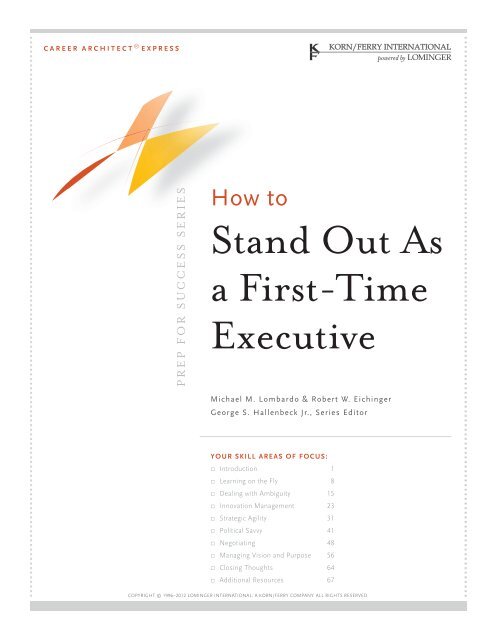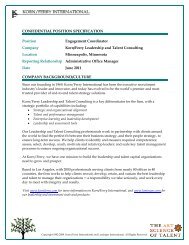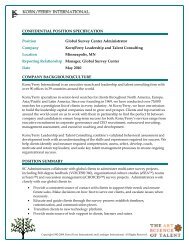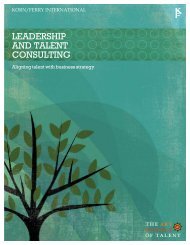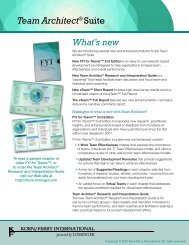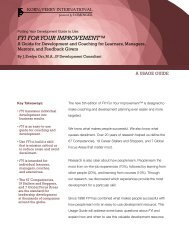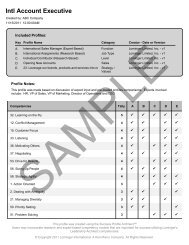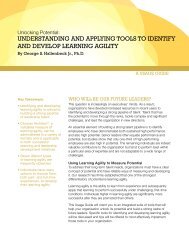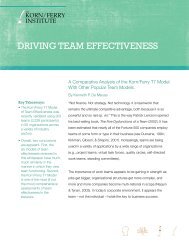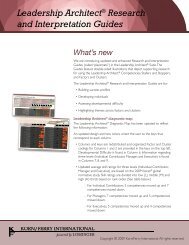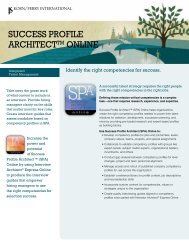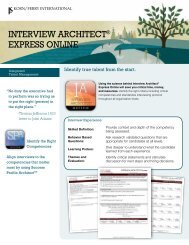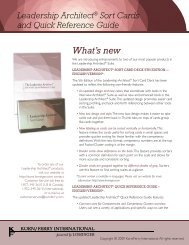Stand Out As a First-Time Executive - Lominger
Stand Out As a First-Time Executive - Lominger
Stand Out As a First-Time Executive - Lominger
Create successful ePaper yourself
Turn your PDF publications into a flip-book with our unique Google optimized e-Paper software.
CAREER ARCHITECT ® EXPRESSPREP FOR SUCCESS SERIESHow to<strong>Stand</strong> <strong>Out</strong> <strong>As</strong>a <strong>First</strong>-<strong>Time</strong><strong>Executive</strong>Michael M. Lombardo & Robert W. EichingerGeorge S. Hallenbeck Jr., Series EditorYOUR SKILL AREAS OF FOCUS:▫ Introduction 1▫ Learning on the Fly 8▫ Dealing with Ambiguity 15▫ Innovation Management 23▫ Strategic Agility 31▫ Political Savvy 41▫ Negotiating 48▫ Managing Vision and Purpose 56▫ Closing Thoughts 64▫ Additional Resources 67COPYRIGHT © 1996–2012 LOMINGER INTERNATIONAL: A KORN/FERRY COMPANY. ALL RIGHTS RESERVED.
HOW TO STAND OUT AS A FIRST-TIME EXECUTIVEAt some point in your career, you have probably been direct witnessto someone who was promoted into an executive role with highexpectations, only to quickly flame out. “What happened?” everyoneasked. This person had all the functional/technical skills requiredfor success, had never before missed performance goals, wasn’t atroublemaker, and was generally well liked. Why the epic fail?The answer, on closer inspection, is often quite simple. This person,while having all the tools to be successful in his or her previous role,kept applying those same tools despite the fact that the new rolecalled for something very different. It’s an easy mistake to make. Afteryears of hearing that you’ve got the “right stuff” and “just keep up thegood work,” you can get caught in a paradoxical rut of success. Thereinforcement and recognition that you get from doing the right thingsin your previous role can carry over so strongly to the next role, that theneed for a shift is recognized too late.The good news is that this outcome is entirely avoidable, but it willrequire you, first, to clearly recognize what separates the executive rolefrom your previous one and, second, to invest in building the skills thatwill help you navigate the transition.After years of hearing that you’ve got the “right stuff”and “ just keep up the good work,” you can get caughtin a paradoxical rut of success.The differences between any executive role and the one that precedesit will vary case by case, but decades of management research haveclued us in to some of the fundamental differences. Here’s a high-level,thematic breakdown of some of the critical and defining shifts that awaityou as you transition to becoming an executive.COPYRIGHT © 1996–2012 LOMINGER INTERNATIONAL: A KORN/FERRY COMPANY. ALL RIGHTS RESERVED.INTRODUCTION2
HOW TO STAND OUT AS A FIRST-TIME EXECUTIVELearning on the FlyMost of us are good at applying what we have seen and done in thepast. Most of us can apply solutions that have worked for us before. Weare all pretty good at solving problems we've seen before. A rarer skill isdoing things for the first time. Solving problems we've never seen before.Trying solutions we have never tried before. Analyzing problems in newcontexts and in new ways. With the increasing pace of change, beingquick to learn and apply first-time solutions is becoming a crucial skill. Itinvolves taking risks, being less than perfect, discarding the past, goingagainst the grain, and cutting new paths. Seldom is anything routine andfamiliar in an executive role. <strong>Time</strong> and time again, you will encounterchallenging, first-time situations that are neither easy to define nor haveobvious solutions. You will need to be a quick and adaptable learner tosucceed.AN EXECUTIVE SKILLED AT LEARNING ON THE FLY: Learns quickly when facing new problems Is a relentless and versatile learner Is open to change Analyzes both successes and failures for clues to improvement Experiments and will try anything to find solutions Enjoys the challenge of unfamiliar tasks Quickly grasps the essence and the underlying structure of anythingLEARNING ON THE FLY CAN BE DIFFICULT IF YOU: Don't analyze successes and failures for clues Are a historical problem solver Are not a risk taker Are not self-confident Are a perfectionist Are stuck in the past Are too narrow in search for parallelsCOPYRIGHT © 1996–2012 LOMINGER INTERNATIONAL: A KORN/FERRY COMPANY. ALL RIGHTS RESERVED.LEARNING ON THE FLY8
HOW TO STAND OUT AS A FIRST-TIME EXECUTIVESome Strategies for Developing Learning on the FlyConsider these remedies as a practical means of jump-starting yourdevelopment on this competency:1. TROUBLE MAKING SENSE OF THE ISSUES? DIG FOR ROOT CAUSES.Keep asking why, see how many causes you can come up with, and howmany organizing buckets you can put them in. This increases the chanceof a better solution because you can see more connections. Chessmasters recognize thousands of possible patterns of chess pieces. Lookfor patterns in data; don’t just collect information. Put it in categoriesthat make sense to you. To better understand new and difficult learning,read The Future of Leadership by White, Hodgson, and Crainer.2. WHERE TO START? LOCATE THE ESSENCE OF THE PROBLEM.What are the key factors or elements in this problem? Experts usuallysolve problems by figuring out what the deep, underlying principlesare and working forward from there; the less adept focus on desiredoutcomes/solutions and either work backward or concentrate on thesurface facts. What are the deep principles of what you’re working on?Once you’ve done this, search the past for parallels—your past, thebusiness past, the historical past. One common mistake here is tosearch in parallel organizations because “only they would know.” Backingup and asking a broader question will aid in the search for solutions.When Motorola wanted to find out how to process orders more quickly,they went not to other electronics firms, but to Domino’s Pizza andFederal Express.3. HOW TO GENERALIZE? LOOK FOR PATTERNS.Look for personal patterns, organizational patterns, or world patternswhen analyzing general successes and failures. What was common toeach success or what was present in each failure but never present in asuccess? Focus on the successes; failures are easier to analyze but don’tin themselves tell you what would work. Comparing successes, whileless exciting, yields more information about underlying principles. Thebottom line is to reduce your insights to principles or rules of thumb youthink might be repeatable. When faced with the next new problem, thosegeneral underlying principles will apply again.COPYRIGHT © 1996–2012 LOMINGER INTERNATIONAL: A KORN/FERRY COMPANY. ALL RIGHTS RESERVED.LEARNING ON THE FLY 10
HOW TO STAND OUT AS A FIRST-TIME EXECUTIVETHINGS YOU CAN DO RIGHT NOWYou don’t have to have a formal role as an executive to exercise your skillat Learning on the Fly. Seek out situations such as the ones describedbelow to get more practice and build your skills in advance. Don’t limityourself to the workplace. Look for opportunities in your life outside ofwork to utilize and develop this competency.Teach a course, seminar, or workshop on something you don’tknow well.Work on a project that involves travel and study of an internationalissue, acquisition, or joint venture and report back to seniorleaders.Work short rotations in other units, functions, or geographiesyou’ve not been exposed to before.Benchmark innovative practices, processes, products, or services ofcompetitors, vendors, suppliers, or customers, and present a reportmaking recommendations for change.Manage a project team made up of nationals from a number ofcountries.SUGGESTED READINGSThese readings can add to your understanding of Learning on the Flyand provide additional ideas for development.Chesbrough, H. (2006). Open business models: How to thrive in the newinnovation landscape. Boston, MA: Harvard Business School Press.DuFour, R., DuFour, R., Eaker, R., & Many, T. (2006). Learning by doing: Ahandbook for professional learning communities at work. Bloomington,IN: Solution Tree.Eichinger, R. W., & Lombardo, M. M. (2004). Learning agility as a primeindicator of potential. Human Resource Planning, 27(4), 12-15.Honold, L. (2001). Developing employees who love to learn: Tools,strategies, and programs for promoting learning at work. Palo Alto, CA:Davies-Black Publishing.Klein, G. A. (2002). Intuition at work: Why developing your gut instinctswill make you better at what you do. New York, NY: Doubleday.Manz, C. C. (2002). The power of failure: 27 Ways to turn life's setbacksinto success. San Francisco, CA: Berrett-Koehler Publishers.COPYRIGHT © 1996–2012 LOMINGER INTERNATIONAL: A KORN/FERRY COMPANY. ALL RIGHTS RESERVED.LEARNING ON THE FLY 13
CAREER ARCHITECT ® EXPRESSCAREER ARCHITECT ® EXPRESSMichael M. Lombardo & Robert W. EichingerGeorge S. Hallenbeck Jr., Series EditorYOUR SKILL AREAS OF FOCUS:▫ Introduction 1▫ Creativity 8▫ Perspective 18▫ Managing and Measuring Work 25▫ Command Skills 32▫ Conflict Management 40▫ Presentation Skills 48▫ Motivating Others 58▫ Closing Thoughts 67▫ Additional Resources 69COPYRIGHT © 1996–2012 LOMINGER INTERNATIONAL: A KORN/FERRY COMPANY. ALL RIGHTS RESERVED.Michael M. Lombardo & Robert W. EichingerGeorge S. Hallenbeck Jr., Series EditorYOUR SKILL AREAS OF FOCUS:▫ Introduction 1▫ Dealing with Ambiguity 7▫ Managing Diversity 15▫ Understanding Others 24▫ Listening 33▫ Dealing with Paradox 40▫ Personal Learning 48▫ Work/Life Balance 55▫ Closing Thoughts 62▫ Additional Resources 64COPYRIGHT © 1996–2012 LOMINGER INTERNATIONAL: A KORN/FERRY COMPANY. ALL RIGHTS RESERVED.HOW TO STAND OUT AS A FIRST-TIME EXECUTIVEAdditional ResourcesOTHER TITLES IN THE CAREER ARCHITECT ® EXPRESS SERIESPREP FOR SUCCESS SERIESHow to<strong>Stand</strong> <strong>Out</strong> <strong>As</strong>a <strong>First</strong>-<strong>Time</strong>ManagerPrep for Success: How to <strong>Stand</strong> <strong>Out</strong> <strong>As</strong> a <strong>First</strong>-<strong>Time</strong> Manager delivers relevant, research-basedguidance on ways to develop the missioncriticalcompetencies that will differentiate youfrom your peers. Whether aspiring to entermanagement for the first time or seeking justin-timecareer-development advice, this how-toguide will provide ideas and direction to help youbuild your skills and get a great start in your firstmanagement role.PREP FOR SUCCESS SERIESHow to<strong>Stand</strong> <strong>Out</strong>in Your <strong>First</strong>International<strong>As</strong>signmentPrep for Success: How to <strong>Stand</strong> <strong>Out</strong> in Your <strong>First</strong>International <strong>As</strong>signment provides an actionable,research-based plan to develop competenciesthat are vital to success in an internationalassignment. Whether contemplating aninternational move or recently relocated, thishow-to guide will provide you with ideas andpointers that will help you make a great impactthrough your assignment.COPYRIGHT © 1996–2012 LOMINGER INTERNATIONAL: A KORN/FERRY COMPANY. ALL RIGHTS RESERVED.ADDITIONAL RESOURCES 67
HOW TO STAND OUT AS A FIRST-TIME EXECUTIVESUPPLEMENTAL RESOURCESThe most effective learners seek insight from multiple sources. Inaddition to all the material provided in How to <strong>Stand</strong> <strong>Out</strong> as a <strong>First</strong>-<strong>Time</strong><strong>Executive</strong>, you can access the useful supplemental resources listed below.Investigate these resources to help you gain additional insight, increaseyour self-awareness, and enhance your success on your job and in yourcareer. All resources listed below are available at http://store.lominger.com.FYI For rInsiInsightnsightThe 21 Leadership Characteristicsfor SUCCESS and the5 that get you FIREDKim E. Ruyle, George S. Hallenbeck Jr.,J. Evelyn Orr &Victoria V.SwisherFYI for Insight: 21 Leadership Characteristicsfor Success and the 5 That Get You Fired startsindividuals on a path toward improvement bybuilding self-awareness. FYI for Insight is used tohelp individuals gain awareness, get to acceptance,and take action to improve performance. In addition,take a FREE online self-awareness assessment athttp://insight.lominger.com.FYI For Your Improvement 5th Edition providesa deeper dive into developmental remedies forcompetencies that comprise the leadershipcharacteristics. It is also an easy-to-use developmentand coaching tool for learners, managers, mentors,coaches, and feedback givers.®Career er ArchirchitecthcDevelopmentPlanner A Systematic tic Approach to Developmentel eIncluding103 Research-Based and Experience-e-Tested ed Development Plans and Coaching Tipsfor learners, managers,mentors, andfeedbackgiversMichael M. Lombardo & Robert W. Eichinger5 th EditionCareer Architect ® Development Planner 5th Editionwas created to help with deeper and more expertdevelopment initiatives. Each chapter providesthe same development content as FYI For YourImprovement with four additional learning sectionsthat focus on long-term experiential development.Voices ® Multi-Rater 360º Feedback System is a Webenabled,competency-based, and research-validated360º feedback tool that provides learners with apowerful tool for development and improvement.COPYRIGHT © 1996–2012 LOMINGER INTERNATIONAL: A KORN/FERRY COMPANY. ALL RIGHTS RESERVED.ADDITIONAL RESOURCES 68
HOW TO STAND OUT AS A FIRST-TIME EXECUTIVECAREER ARCHITECT ® EXPRESSPrep for Success Series: How to <strong>Stand</strong> <strong>Out</strong> <strong>As</strong> a <strong>First</strong>-<strong>Time</strong> <strong>Executive</strong>IMPORTANT NOTICE:COPYRIGHT © 1996–2012LOMINGER INTERNATIONAL: A KORN/FERRY COMPANYALL RIGHTS RESERVED.No part of this work may be copied or transferred to any otherexpression or form without a license from<strong>Lominger</strong> International: A Korn/Ferry Company.Tel. +1 952-345-3610Tel. +1 877-345-3610 (US/Canada)Fax. +1 952-345-3601www.kornferry.comwww.lominger.comCareer Architect ® is the exclusive registered trademark of<strong>Lominger</strong> International: A Korn/Ferry Company.Item number: 82195COPYRIGHT © 1996–2012 LOMINGER INTERNATIONAL: A KORN/FERRY COMPANY. ALL RIGHTS RESERVED.CAREER ARCHITECT © EXPRESS 69
CAREER ARCHITECT ® EXPRESSAbout Korn/Ferry InternationalKorn/Ferry International isa premier global provider oftalent management solutions,with a presence throughout theAmericas, <strong>As</strong>ia Pacific, Europe,the Middle East and Africa.The firm delivers services andsolutions that help clients cultivategreatness through the attraction,engagement, development andretention of their talent.Visit kornferry.comfor more information onKorn/Ferry International.COPYRIGHT © 1996–2012 LOMINGER INTERNATIONAL: A KORN/FERRY COMPANY. ALL RIGHTS RESERVED.


